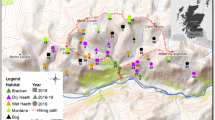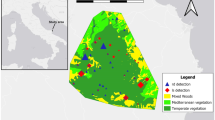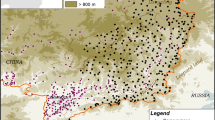Abstract
Context
Livestock grazing is one of the most widespread types of anthropogenic land use, even occurs in many protected areas and has become a threat to wildlife worldwide. Understanding livestock-wildlife interactions is crucial for rare large carnivores conservation. In China, free-ranging cattle within forests degrade the habitat of the tigers (Panthera tigris) and leopards (Panthera pardus), but quantitative assessments of how livestock affect the spatial and temporal use by the major ungulate prey of the two endangered felids are very limited.
Objectives
This study aimed to examine the interactions of several sympatric wildlife species with livestock at a fine spatiotemporal scale in a human-dominated forest landscape.
Methods
Based on a large-scale camera-trapping data across the China-Russia border, we used N-mixture models, two-species occupancy models and activity pattern overlap to understand the effects of cattle grazing on three ungulate species (sika deer Cervus nippon, wild boars Sus scrofa and roe deer Capreolus pygargus).
Results
Spatially, with cattle activity increasing, wild boar and roe deer had different degrees of decline in the intensity of habitat use. Sika deer were displaced as more cattle encroached on forest habitat. Temporally, in the presence of cattle, wild boar and sika deer decreased their activities in the day. In addition, three wild ungulates trend to exhibit lower spatiotemporal overlap with cattle at shared camera sites.
Conclusions
Our study shows that wildlife species may reduce the probability of habitat use by spatial avoidance and changing the daily activity patterns. We underscore that fine-scale (i.e. camera-site level) spatiotemporal avoidance is likely a key component of co-occurrence between livestock and the sympatry of competing ungulates inhabiting forest ecosystems. Given prey were depressed, efforts to minimize the livestock disturbance on these species need to be considered to ensure their sustained recoveries.





Similar content being viewed by others
Data availability
The dataset analyzed during the current study is available from the long-term Tiger Leopard Observation Network (TLON) in China by request.
References
Apollonio M, Andersen R, Putman R (2010) European ungulates and their management in the 21st Century. Cambridge University Press, Cambridge
Aramilev VV (2009) Sika deer in Russia. In: McCullough DR, Takatsuki S, Kaji K (eds) Sika deer: Biology and management of native and introduced populations. Springer, Japan, pp 475–499
Ballari SA, Barrios-Garcia MN (2014) A review of wild boar Sus scrofa diet and factors affecting food selection in native and introduced ranges. Mamm Rev 44:124–134
Barker RJ, Schofield MR, Link WA, Sauer JR (2018) On the reliability of N-mixture models for count data. Biometrics 74:369–377
Boyce MS, McDonald LL (1999) Relating populations to habitats using resource selection functions. Trends Ecol Evol 14:268–272
Burnham KP, Anderson DR (2012) Model selection and multimodel inference. A practical information theoretic approach. Springer, New York
Dave C, Jhala Y (2011) Is competition with livestock detrimental for native wild ungulates? A case study of chital (Axis axis) in Gir Forest, India. J Trop Ecol 27:239–247
De Reu J, Bourgeois J, Bats M, Zwertvaegher A, Gelorini V, De Smedt P, Chu W, Antrop M, De Maeyer P, Finke P, Van Meirvenne M, Verniers J, Crombe P (2013) Application of the topographic position index to heterogeneous landscapes. Geomorphology 186:39–49
Dettenmaier SJ, Messmer TA, Hovick TJ, Dahlgren DK (2017) Effects of livestock grazing on rangeland biodiversity: a meta-analysis of grouse populations. Ecol Evol 7:7620–7627
Dormann CF, Elith J, Bacher S, Buchmann C, Carl G, Carre G, Marquez JRG, Gruber B, Lafourcade B, Leitao PJ, Munkemuller T, McClean C, Osborne PE, Reineking B, Schroder B, Skidmore AK, Zurell D, Lautenbach S (2013) Collinearity: a review of methods to deal with it and a simulation study evaluating their performance. Ecography 36:27–46
Dou HL, Yang HT, Smith JLD, Feng LM, Wang TM, Ge JP (2019) Prey selection of Amur tigers in relation to the spatiotemporal overlap with prey across the Sino-Russian border. Wildl Biol 1:wlb.00508
Filazzola A, Brown C, Dettlaff MA, Batbaatar A, Grenke J, Bao T, Peetoom Heida I, Cahill JF Jr (2020) The effects of livestock grazing on biodiversity are multi-trophic: a meta-analysis. Ecol Lett 23:1298–1309
Fiske IJ, Chandler RB (2011) Unmarked: An R package for fitting hierarchical models of wildlife occurrence and abundance. J Stat Softw 43:1–23
Hayward MW, Jedrzejewski W, Jedrzewska B (2012) Prey preferences of the tiger Panthera tigris. J Zool 286:221–231
Hebblewhite M, Miquelle DG, Robinson H, Pikunov DG, Dunishenko YM, Aramilev VV, Nikolaev IG, Salkina GP, Seryodkin IV, Gaponov VV, Litvinov MN, Kostyria AV, Fomenko PV, Murzin AA (2014) Including biotic interactions with ungulate prey and humans improves habitat conservation modeling for endangered Amur tigers in the Russian Far East. Biol Conserv 178:50–64
Hebblewhite M, Zimmermann F, Li Z, Miquelle D, Zhang M, Sun H, Mörschel F, Wu Z, Sheng L, Purekhovsky A (2012) Is there a future for Amur tigers in a restored tiger conservation landscape in Northeast China? Anim Conserv 15:579–592
Herfindal I, Lande US, Solberg EJ, Rolandsen CM, Roer O, Wam HK (2017) Weather affects temporal niche partitioning between moose and livestock. Wildl Biol 18:wlb.00275
Hibert F, Calenge C, Fritz H, Maillard D, Bouche P, Ipavec A, Convers A, Ombredane D, de Visscher MN (2010) Spatial avoidance of invading pastoral cattle by wild ungulates: insights from using point process statistics. Biodivers Conserv 19:2003–2024
Hines JE (2017) PRESENCE 12.6—Estimates patch occupancy rates and related parameters. USGS-PWRC. http://www.mbr-pwrc.usgs.gov/software/presence.html
Hojnowski CE, Miquelle DG, Myslenkov AI, Strindberg S, Smirnov EN, Goodrich JM (2012) Why do Amur tigers maintain exclusive home ranges? Relating ungulate seasonal movements to tiger spatial organization in the Russian Far East. J Zool 287:276–282
Johnson A, Goodrich J, Hansel T, Rasphone A, Saypanya S, Vongkhamheng C, Venevongphet SS (2016) To protect or neglect? Design, monitoring, and evaluation of a law enforcement strategy to recover small populations of wild tigers and their prey. Biol Conserv 202:99–109
Karanth KU, Nichols JD, Kumar NS, Link WA, Hines JE (2004) Tigers and their prey: predicting carnivore densities from prey abundance. Proc Natl Acad Sci USA 101:4854–4858
Karanth KU, Srivathsa A, Vasudev D, Puri M, Parameshwaran R, Kumar NS (2017) Spatio-temporal interactions facilitate large carnivore sympatry across a resource gradient. Proc R Soc B 284:20161860
Keever AC, McGowan CP, Ditchkoff SS, Acker PK, Grand JB, Newbolt CH (2017) Efficacy of N-mixture models for surveying and monitoring white-tailed deer populations. Mamm Res 62:413–422
Kerley LL, Mukhacheva AS, Matyukhina DS, Salmanova E, Salkina GP, Miquelle DG (2015) A comparison of food habits and prey preference of Amur tiger (Panthera tigris altaica) at three sites in the Russian Far East. Integr Zool 10:354–364
Kery M (2018) Identifiability in N-mixture models: a large-scale screening test with bird data. Ecology 99:281–288
Kronfeld-Schor N, Dayan T (2003) Partitioning of time as an ecological resource. Annu Rev Ecol Evol Syst 34:153–181
Lahkar D, Ahmed MF, Begum RH, Das SK, Harihar A (2020) Responses of a wild ungulate assemblage to anthropogenic influences in Manas National Park, India. Biol Conserv 243:108425
Lashley MA, Cove MV, Chitwood MC, Penido G, Gardner B, DePerno CS, Moorman CE (2018) Estimating wildlife activity curves: comparison of methods and sample size. Sci Rep 8:4173
Li BBV, Pimm SL, Li S, Zhao LJ, Luo CP (2017) Free-ranging livestock threaten the long-term survival of giant pandas. Biol Conserv 216:18–25
Li ZL, Wang TM, Smith JLD, Feng RN, Feng LM, Mou P, Ge JP (2019) Coexistence of two sympatric flagship carnivores in the human-dominated forest landscapes of Northeast Asia. Landsc Ecol 34:291–305
Li ZW, Wu JG, Kou XJ, Tian Y, Wang TM, Mu P, Ge JP (2009) Land use pattern and its dynamic changes in Amur tiger distribution region. Chin J Appl Ecol 20:713–724
MacKenzie DI, Bailey LL, Nichols JD (2004) Investigating species co-occurrence patterns when species are detected imperfectly. J Anim Ecol 73:546–555
Madhusudan MD (2004) Recovery of wild large herbivores following livestock decline in a tropical Indian wildlife reserve. J Appl Ecol 41:858–869
McLaughlin K (2016) Tiger Land. Science 353:744–745
Meredith M, Ridout M (2017) overlap: Estimates of coefficient of overlapping for animal activity patterns R package version 0.3.0. https://cran.r-project.org/web/packages/overlap/index.html
Ning Y, Kostyria AV, Ma JZ, Chayka MI, Guskov VY, Qi JZ, Sheremetyeva IN, Wang M, Jiang GS (2019) Dispersal of Amur tiger from spatial distribution and genetics within the eastern Changbai mountain of China. Ecol Evol 9:2415–2424
Odadi WO, Karachi MK, Abdulrazak SA, Young TP (2011) African wild ungulates compete with or facilitate cattle depending on season. Science 333:1753–1755
O’Brien TG, Kinnaird MF, Wibisono HT (2003) Crouching tigers, hidden prey: Sumatran tiger and prey populations in a tropical forest landscape. Anim Conserv 6:131–139
Paudel PK, Kindlmann P (2012) Human disturbance is a major determinant of wildlife distribution in Himalayan midhill landscapes of Nepal. Anim Conserv 15:283–293
Pudyatmoko S (2017) Free-ranging livestock influence species richness, occupancy, and daily behaviour of wild mammalian species in Baluran National Park, Indonesia. Mamm Biol 86:33–41
Richmond OMW, Hines JE, Beissinger SR (2010) Two-species occupancy models: a new parameterization applied to co-occurrence of secretive rails. Ecol Appl 20:2036–2046
Ridout MS, Linkie M (2009) Estimating overlap of daily activity patterns from camera trap data. J Agric Biol Environ Stat 14:322–337
Robinson TP, Wint GR, Conchedda G, Van Boeckel TP, Ercoli V, Palamara E, Cinardi G, D'Aietti L, Hay SI, Gilbert M (2014) Mapping the global distribution of livestock. PLoS ONE 9:e96084
Romero D, Olivero J, Brito JC, Real R (2016) Comparison of approaches to combine species distribution models based on different sets of predictors. Ecography 39:561–571
Rowcliffe JM, Field J, Turvey ST, Carbone C (2008) Estimating animal density using camera traps without the need for individual recognition. J Appl Ecol 45:1228–1236
Royle JA (2004) N-mixture models for estimating population size from spatially replicated counts. Biometrics 60:108–115
Say-Sallaz E, Chamaille-Jammes S, Fritz H, Valeix M (2019) Non-consumptive effects of predation in large terrestrial mammals: mapping our knowledge and revealing the tip of the iceberg. Biol Conserv 235:36–52
Schieltz JM, Rubenstein DI (2016) Evidence based review: positive versus negative effects of livestock grazing on wildlife. What do we really know? Environ Res Lett 11:113003
Schoener TW (1974) Resource partitioning in ecological communities. Science 185:27–39
Shamoon H, Dayan T, Saltz D (2017a) Cattle grazing effects on mountain gazelles in Mediterranean natural landscapes. J Wildl Manag 81:1351–1362
Shamoon H, Saltz D, Dayan T (2017b) Fine-scale temporal and spatial population fluctuations of medium sized carnivores in a Mediterranean agricultural matrix. Landsc Ecol 32:1243–1256
Soh YH, Carrasco LR, Miquelle DG, Jiang JS, Yang J, Stokes EJ, Tang JR, Kang AL, Liu PQ, Rao M (2014) Spatial correlates of livestock depredation by Amur tigers in Hunchun, China: relevance of prey density and implications for protected area management. Biol Conserv 169:117–127
Soofi M, Ghoddousi A, Zeppenfeld T, Shokri S, Soufi M, Jafari A, Ahmadpour M, Qashqaei AT, Egli L, Ghadirian T, Chahartaghi NR, Zehzad B, Kiabi BH, Khorozyan I, Balkenhol N, Waltert M (2018) Livestock grazing in protected areas and its effects on large mammals in the Hyrcanian forest. Iran Biol Conserv 217:377–382
Stewart KM, Bowyer RT, Kie JG, Cimon NJ, Johnson BK (2002) Temporospatial distributions of elk, mule deer, and cattle: Resource partitioning and competitive displacement. J Mammal 83:229–244
Sugimoto T, Aramilev VV, Nagata J, McCullough DR (2016) Winter food habits of sympatric carnivores, Amur tigers and Far Eastern leopards, in the Russian Far East. Mamm Biol 81:214–218
Valls-Fox H, Chamaillé-Jammes S, de Garine-Wichatitsky M, Perrotton A, Courbin N, Miguel E, Guerbois C, Caron A, Loveridge A, Stapelkamp B, Muzamba M, Fritz H (2018) Water and cattle shape habitat selection by wild herbivores at the edge of a protected area. Anim Conserv 21:365–375
Vitkalova AV, Feng LM, Rybin AN, Gerber BD, Miquelle DG, Wang TM, Yang HT, Shevtsova EI, Aramilev VV, Ge JP (2018) Transboundary cooperation improves endangered species monitoring and conservation actions: a case study of the global population of Amur leopards. Conserv Lett 11:12574
Wang L, Tseveen A, Yang LM, Huang CM, Li D, Zhu XL, Feng LM, Wang TM, Ge JP, Mu P (2019) Forest cattle grazing affects understory food resource of ungulates in the eastern part of the Northeast Tiger and Leopard National Park. Acta Theriol Sin 39:386–396
Wang TM, Feng LM, Mou P, Ge JP, Li C, Smith JLD (2015) Long-distance dispersal of an Amur tiger indicates potential to restore the North-east China/Russian Tiger Landscape. Oryx 49:578–579
Wang TM, Feng LM, Mou P, Wu JG, Smith JLD, Xiao WH, Yang HT, Dou HL, Zhao XD, Cheng YC, Zhou B, Wu HY, Zhang L, Tian Y, Guo QX, Kou XJ, Han XM, Miquelle DG, Oliver CD, Xu RM, Ge JP (2016) Amur tigers and leopards returning to China: direct evidence and a landscape conservation plan. Landsc Ecol 31:491–503
Wang TM, Feng LM, Yang HT, Han BY, Zhao YH, Juan L, Lu XY, Zou L, Li T, Xiao WH, Mou P, Smith JLD, Ge JP (2017) A science-based approach to guide Amur leopard recovery in China. Biol Conserv 210:47–55
Wang TM, Royle JA, Smith JLD, Zou L, Lu XY, Li T, Yang HT, Li ZL, Feng RN, Bian YJ, Feng LM, Ge JP (2018) Living on the edge: opportunities for Amur tiger recovery in China. Biol Conserv 217:269–279
Wisz MS, Pottier J, Kissling WD, Pellissier L, Lenoir J, Damgaard CF, Dormann CF, Forchhammer MC, Grytnes JA, Guisan A, Heikkinen RK, Hoye TT, Kuhn I, Luoto M, Maiorano L, Nilsson MC, Normand S, Ockinger E, Schmidt NM, Termansen M, Timmermann A, Wardle DA, Aastrup P, Svenning JC (2013) The role of biotic interactions in shaping distributions and realised assemblages of species: implications for species distribution modelling. Biol Rev 88:15–30
Zhang JD, Hull V, Ouyang ZY, Li RG, Connor T, Yang HB, Zhang ZJ, Silet B, Zhang HM, Liu JG (2017) Divergent responses of sympatric species to livestock encroachment at fine spatiotemporal scales. Biol Conserv 209:119–129
Zhou SC, Zhang MH (2011) An integrated analysis into the causes of ungulate mortality in the Wanda Mountains (Heilongjiang Province, China) and an evaluation of habitat quality. Biol Conserv 144:2517–2523
Zuur AF, Saveliev AA, Ieno EN (2012) Zero inflated models and generalized linear mixed models with R. Highland Statistics Ltd, Newburgh
Acknowledgements
We thank Daniel Eacker and the anonymous referees for their comments and suggestions that greatly improved our manuscript. This work was supported by the National Key Research and Development Program (2016YFC0500106) and grants from the National Natural Science Foundation of China (31971539, 31270567, 31700469). This project was carried out with the approval of Chinese National Forestry and grassland Administration and Northeast Tiger Leopard National Park. Non-invasive camera-trapping technology did not involve direct contact with animals. All study was in accordance with the guidelines approved by The American Society of Mammologists.
Author information
Authors and Affiliations
Corresponding author
Additional information
Publisher's Note
Springer Nature remains neutral with regard to jurisdictional claims in published maps and institutional affiliations.
Supplementary Information
Below is the link to the electronic supplementary material.
Rights and permissions
About this article
Cite this article
Feng, R., Lü, X., Xiao, W. et al. Effects of free-ranging livestock on sympatric herbivores at fine spatiotemporal scales. Landscape Ecol 36, 1441–1457 (2021). https://doi.org/10.1007/s10980-021-01226-6
Received:
Accepted:
Published:
Issue Date:
DOI: https://doi.org/10.1007/s10980-021-01226-6




